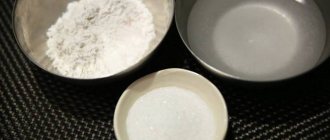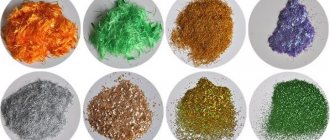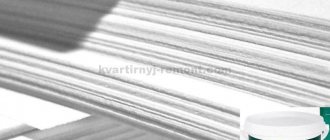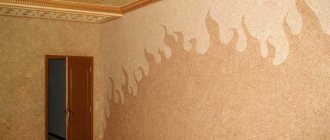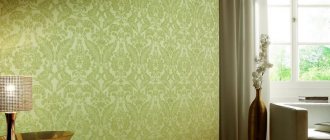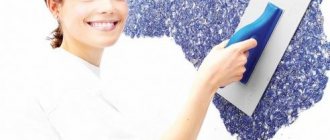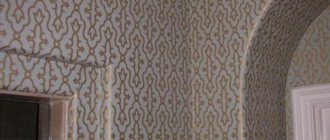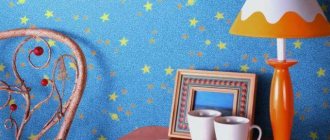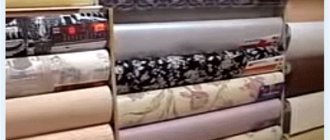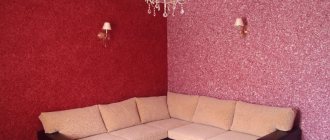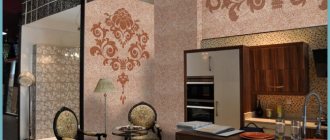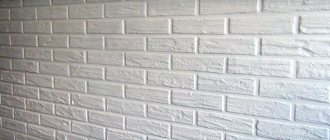Liquid wallpaper: composition, types, advantages and disadvantages
Repair work in a house or apartment almost always includes wall decoration. Liquid wallpaper can be considered one of the most flexible, environmentally friendly, safe and durable coatings. Many consumers are interested in what liquid wallpaper is made of
and whether it can be considered a type of ordinary paper wallpaper. The answer is obvious: liquid wallpaper cannot be considered wallpaper in the full sense. Most likely, this is a material intended for finishing walls or ceilings, which combines the best qualities of decorative plaster, paper wallpaper and paint coatings.
Liquid or wet wallpaper is a volumetric mixture consisting of water, cotton fibers, silk or cellulose and acrylic additives to add color. And the binder in this composition is glue. The mixture may also include sparkles of various diameters, pieces of mica, mother-of-pearl, mineral chips, threads and other materials. After application to the wall, the composition dries, holding all the components together and leaving an elastic coating on the surface.
What liquid wallpaper looks like on a wall in the interior
You can use liquid wallpaper to cover walls in any room. The material helps hide surface imperfections. The main task is to give the wall a look that allows you to create the intended interior. Using the coating in question, you can achieve a large number of decorative effects. For example, form a specific pattern or bas-relief, apply stripes with a change in direction, or paint the surface in any color. The choice of option depends on the preferences of the designer and the style of the room.
Liquid wallpaper in the living room
Lilac tones in the bedroom
Combination of dark walls and light floors in the hallway
Accent wall at the head
Drawing on the wall in the hallway
What types of liquid wallpaper are there?
Depending on the type of filler, liquid wallpaper
may be of the following types:
- Cellulose - this variety is considered the most affordable option, as it has the lowest price compared to other types. Liquid wallpaper is based on a product of wood processing - cellulose; sawdust is also often used. This type of wallpaper is ideal for treating walls with small flaws, as it tends to hide them, and for creating a covering in unheated rooms. Cellulose liquid wallpaper is inferior in decorative properties to silk wallpaper and is less resistant to sunlight.
- Silk is a type of finishing material that is considered the most expensive and has excellent decorative qualities. The composition of such wallpaper includes silk fibers, thanks to which the coating on the surface of the walls looks like fabric wallpaper. This type of finish has increased wear resistance and does not fade in the sun. It can be applied to concrete, plasterboard surfaces that do not have large cracks.
- Cotton is a liquid wallpaper that contains cotton. They are an environmentally friendly and hypoallergenic finishing material. This coating is very warm and pleasant to the touch. In addition, to obtain a varied texture, mica impurities, various decorative additives, and cellulose are added to the mixture.
- A mixture of cellulose and silk fibers - this type of liquid wallpaper is considered the “golden mean”, since it occupies an intermediate place in the price category. The mixture may also contain cotton fibers, as a result of which the coating is quite elastic and attractive in appearance.
Depending on the initial state, liquid wallpaper is divided into two types: dry powder, packaged in bags, and material in a liquid state. The dry mixture contains all the necessary elements in its composition, and the consumer only has to dilute it in a container with water. The powder package includes detailed instructions on how to use the mixture. One package is usually enough to cover a wall surface area of 3 to 5 square meters. And for those who will be using liquid wallpaper for the first time, the second option is preferable, since the mixture is already completely ready for application. But no matter what types of liquid wallpaper
purchased, special rollers, spatulas or sprayers are used to finish the walls.
Gluing technology
The following tools are used for gluing liquid wallpaper: a trowel, a grater, a spatula, a gun and a spray bottle.
DIY application sequence:
- We scoop up the solution with our hands or a spatula, carefully apply the mixture in small portions to the wall. You need to grind this mass to a thickness of 2-3 mm.
- It is not recommended to tear the working trowel off the walls, as this will lead to the formation of seams; you should not press too hard on the trowel.
- We continue to paste over the walls in this way, each area is 1 sq. m. area is leveled with a grater soaked in water so that there are no grooves or lumps on the walls.
- To make the surface smooth and even, go over it again with a spatula dipped in water.
- It will take 2-3 days for the coatings to dry, but be sure to ventilate the room and maintain a favorable temperature in the room - at least plus 10 degrees.
How to properly hang liquid wallpaper with your own hands is shown in the video:
Tips for working with liquid wallpaper yourself:
- if the solution is too thick, dilute it a little with water - no more than one liter per serving;
- when leveling the surface, guide the grater with the front edge 5-15 degrees;
- to level liquid wallpaper, move from the corners to the sides in a circular motion;
- the remains will be useful for correcting deficiencies;
- You can remove dirt from the wallpaper using a spatula, which needs to be moistened with water, then create a new batch and cover the walls again with liquid wallpaper;
- To ensure that liquid wallpaper retains its appearance longer, use special protective coatings: acrylic varnishes, primer;
- To clean the wallpaper from dust, dry cleaning with a vacuum cleaner is required. To clean varnished surfaces, you need to wipe them with a damp cloth;
- To correctly apply a pattern of liquid wallpaper, you need to move along the drawn lines from the center to the edges. It will take a day to dry, then you should adjust the image with a rubber spatula, the excess is removed with a knife.
Liquid wallpaper is functional, environmentally friendly, pleasant to the touch, easy to install and maintain, suitable for different rooms and styles. They are most often used in the corridor, due to their resistance to dirt. Selecting a high-quality composition yourself is not difficult, the main thing is to observe the proportions and maintain the cooking time. Take into account our advice on gluing coating technology and create competent interiors!
Recommended Posts
Decorating the corridor with liquid wallpaper
How to remove liquid wallpaper from the wall and stains from liquid wallpaper
What can be done from old wallpaper
How to make liquid wallpaper at home
Types of liquid wallpaper
Is it possible to apply liquid wallpaper to drywall?
What properties does the material have?
Liquid wallpaper contains natural components that have an excellent antistatic effect and good fire resistance. This type of finishing material has excellent heat and sound insulation properties. It can be used to hide surface unevenness or even large damage due to its plasticity. Liquid wallpaper is often applied even to pipes and radiators that are pre-coated with insulating material, as a result of which the material prevents rust.
Coating characteristics
An increasing number of consumers are choosing liquid wallpaper to decorate their homes. Firstly, this is an unusual coating with an interesting texture. And, secondly, the material has a number of positive qualities:
- Easy to apply - you can even decorate walls with wallpaper yourself.
- Possibility of repair - damaged or contaminated areas are cleaned and replaced with a new mixture.
- Durability – wallpaper lasts up to 10 years.
- Antistatic – the coating does not contain synthetic additives, so it does not attract dust and dirt.
- The heat and sound insulation qualities of the material are higher than those of conventional wallpaper and plaster.
- Vapor permeability ensures a normal indoor microclimate.
- Moisture capacity – walls with such a coating are able to absorb excess moisture and release it if necessary.
- The natural composition is not harmful to health and the environment.
- Fire safety - wallpaper is prone to self-extinguishing, it does not spread flame.
- Warmth and softness of finish.
- Seamless - a homogeneous layer of the mixture easily decorates corners, arches, niches, baseboards and other elements.
- Possibility of coloring both the liquid mixture and the dried coating.
- Easy to maintain - walls can be vacuumed or wiped with a slightly damp sponge.
- Antibacterial additives prevent the development of mold on the surface.
- Simple dismantling - when the wallpaper needs to be removed, it is simply moistened with water and cleaned off with a spatula.
Each characteristic speaks in favor of the material. The only drawback of liquid wallpaper is its cost. However, in terms of square meters, the mixture is not so expensive. And if you apply it yourself, you can also save money.
Advantages and disadvantages of wall finishing material
Like any other material intended for finishing the surface of walls or ceilings, liquid wallpaper has its advantages and disadvantages. The indisputable advantages of the coating include the following:
- The mixture, presented in the form of a dry powder, is very easily diluted with water, and you don’t even need to use a mixing attachment for stirring, but do everything by hand;
- All types of coatings are environmentally friendly, safe for people and can be used, including for finishing a child’s room, and used in educational and medical institutions;
- Unlike paper wallpaper, liquid wallpaper forms a seamless coating and when applied there is no need for joining or adjustment in the corners of rooms;
- You can optionally add various additives to the mixture, for example, compounds that prevent the appearance of mold, mildew, etc.;
- The service life of the material is practically unlimited;
- Even an unskilled worker with no experience can handle applying the solution to the wall;
- If, over time, the coating on a certain section of the wall needs to be repaired or replaced for some reason, this can be done easily and almost imperceptibly;
- This material allows you to decorate walls in an original way and to your taste due to its excellent plasticity, for example, to apply patterns or make panels;
- Dismantling wet wallpaper also does not take much time and goes quickly, without disturbing the base of the walls;
- The removed coating can be used for reapplication;
- Compared to some other materials for wall decoration, liquid wallpaper, even silk, is much cheaper;
- Due to its high elasticity, liquid wallpaper is widely used by designers to create three-dimensional designs, intricate patterns and even paintings;
- Liquid wallpaper can be combined with other materials, such as photo wallpaper, ceramic tiles, artificial and natural stone to create a specific effect.
Speaking about the disadvantages of wet wallpaper, it is worth noting that there are not many of them. The disadvantages of the finishing material are the following:
- The coating is not moisture resistant and may therefore deteriorate if exposed to water. For this reason, it is not recommended for use in the bathroom or kitchen. However, if you add special protective additives to the prepared mixture or apply colorless acrylic varnish in several layers over the dried finish, you can get a washable decorative surface.
- The relief texture attracts dust and promotes its settling. But this drawback can be easily eliminated if you regularly carry out dry cleaning and clean the walls with a vacuum cleaner.
- The color scheme is pastel tones, there are no bright accents;
- It is better to apply wet wallpaper on a slightly rough surface, since on a very smooth surface the coating may simply run off.
What are the pros and cons of liquid wallpaper?
Before using such coatings for application on surfaces, you need to familiarize yourself with their advantages and pay attention to the disadvantages.
Liquid wallpaper has the following pros and cons:
- The advantages include their rapid drying, the ability to apply the mixture to uneven walls and successful removal of minor surface defects (roughness, seams).
- Thanks to its environmentally friendly composition, wallpaper can be used to cover walls in all rooms, including children's rooms, which has allowed such coatings to earn positive reviews.
- Wallpaper is characterized by elasticity and can stay on the walls for a long time, which is much more profitable than using roll wallpaper.
- An important advantage is their good air conductivity. That is, thanks to such a breathable coating, you can count on a healthy microclimate in the room.
All types of liquid wallpaper do not burn, do not accumulate dust, are odorless and are environmentally friendly
Become the designer of your own apartment, show everyone your unique style and don’t be afraid to experiment
When choosing a liquid mixture for decorating walls, you should undoubtedly take into account all the advantages of such a coating. However, there are certain disadvantages that also require attention:
- The disadvantages include a contraindication to the use of such wallpaper in rooms where there is high humidity.
- Sometimes damage to the wall occurs during operation. But such deficiencies can be corrected by applying a new mixture.
By the way, an important question that may bother many people is whether they should give preference to such surface finishing - are there any contraindications for using such wallpaper?
Related article: Interior glossy doors: choosing and evaluating white doors
How to prepare the mixture for application?
In order to dilute the powder and prepare wet wallpaper for application to the surface, you need to perform the following steps:
- Pour the powder into a deep container and fill it with warm water. Water temperature - no less than 30 and no more than 35 degrees. The fact is that if you pour the mixture with a very hot liquid, it will become unsuitable for application, and if it is too cold, the process of preparing the solution will be delayed.
- Using a mixing attachment and a screwdriver, mix the solution. In addition, a fairly common option for preparing the mass is to knead the powder with your hands until you obtain a homogeneous consistency, somewhat reminiscent of minced meat.
- The solution should stand for 10-15 minutes, and then begin finishing the walls.
Before preparing the solution, be sure to read the instructions and follow all the manufacturer’s instructions. The instructions indicate how much water, depending on the composition, must be added. Many consumers find it convenient to stir the mixture in a plastic bucket with their hands. There is no need to be afraid that the solution will have a negative effect on the skin: it does not contain chemical additives, which means there will be no irritation on the skin. Some manufacturers recommend putting the finished mass back into the bag, tying the neck and leaving the solution for several hours (at least 4) for uniform swelling.
Applying wallpaper yourself
Decorating walls with liquid wallpaper is much easier than decorating them with decorative plaster. Although these processes are largely similar. The lightness lies in the texture of the liquid finish - the mass is quite plastic and heterogeneous.
To start work, select one of the corners. Place a little mixture on a wide plastic spatula and press it against the wall. The material is leveled using reciprocating movements; circular movements cannot be used so as not to damage the structure.
Advice! There is no need to use metal spatulas and graters - they can easily damage the fibers and damage the structure of the wallpaper.
The next section should overlap the border of the previous one - there should be no seams on the coating. Therefore, it is important not to interrupt work - you need to finish at least one of the walls at a time.
The thickness of the layer over the entire area should be the same. After applying a square meter of wallpaper, they are leveled with a grater. The finish can be adjusted within 1-2 hours after installation; to do this, the grater is moistened with water.
Wallpaper is applied to the ceiling as easily as it is to the walls. In this case, the mixture can be made a little thicker.
In some cases, the material is applied with a roller or spray - this is acceptable when the consistency of the wallpaper is less than usual. In addition, they use stencils and create drawings and even paintings from multi-colored wallpaper. Such techniques allow you to obtain an unusual coating, slightly different from standard liquid wallpaper.
The wallpaper takes about 2-3 days to dry. It all depends on the air temperature and humidity level. The optimal temperature is considered to be from 10 to 25 degrees.
Is it possible to make liquid wallpaper yourself?
Liquid wallpaper is a type of finishing coating that you can make yourself. The composition of the homemade mixture is quite simple. To prepare it, you will need old waste paper, for example, newspapers, magazines, pieces of old paper wallpaper, various dyes, PVA glue, water, pieces of mica, sawdust, mineral chips, and various additives to create an unusual texture. And in this case, the choice depends solely on the taste preferences of the home owner.
The process of preparing the solution with your own hands does not take much time and is quite simple. So, how to make liquid wallpaper yourself?
First, water is poured into the container, and then finely chopped paper is placed and left for a while so that it is well saturated and sour. Then, using a drill and a mixing attachment, the components are mixed until a homogeneous mass is obtained. Then glue, dyes and decorative additives are added to the solution. The mixture is thoroughly mixed, and gypsum is added last. It is not recommended to prepare a large amount of the mixture at one time, as it begins to thicken during application. Before the solution hardens, it is necessary to completely develop the finishing material.
In addition, when making homemade wallpaper mixtures, cotton and cellulose fibers, such as cotton wool or wood cellulose-based insulation, are often used. Wool, twine, and flax fiber can also be added to the composition - all this affects how the liquid wallpaper on the wall will ultimately look.
Of course, a mixture prepared at home yourself is a very budget-friendly option for liquid wallpaper. But this material has some disadvantages. If you neglect the technology for preparing the solution or use low-quality components, the finish may peel off or lie on the surface in lumps.
How to knead correctly
When purchasing a ready-made mixture, there is always a description of the preparation process. For all types it is almost the same:
- you should take the amount of water indicated in the instructions;
- pour the dry mixture into water, and not vice versa;
- each package should be mixed in one container, pour out all the contents at once, and not in parts;
- since there are no harmful substances in liquid wallpaper, you can mix it with your hands;
- To prevent the structure and length of the fibers from being damaged, refuse to use the equipment;
- calculate how much liquid wallpaper you will need at once, with different batches the shades will be slightly different, so you cannot use mixtures from different batches to finish one wall;
- the remains of one composition can be added to the second solution; store the prepared mixture in a closed place for several weeks;
How to properly make liquid wallpaper with your own hands, watch the video:
How is liquid coating applied?
In many ways, the technology for applying liquid wallpaper to the surface of walls is similar to finishing with decorative plaster. Therefore, consumers who want to know how to glue liquid wallpaper
must be able to properly use any dry decorative mixtures.
The first thing you need to do is prepare your working tools and materials: ready-made mixture, trowel, rollers, spatulas, rags, stepladder, water. When applying the mixture to the wall, it is important to adhere to some rules:
- A layer of mortar is laid along the entire length of the blade of a wide spatula and then rubbed over the surface of the wall;
- The finishing material should be applied to the walls from the middle from the ceiling itself and then move to the sides from the center;
- To finish the corners, use a narrow spatula;
- If the layer is applied too tightly or there are some flaws, this area is cleaned off and the solution is applied again;
- In order to reduce the consumption of liquid wallpaper, you can pre-paint the walls to match the finish coat, and if the liquid wallpaper is transparent, the flaws will not be so visible.
It is convenient to apply the solution using a trowel with a transparent plastic working surface. This method will allow even beginners to distribute the mass on the wall surface without any flaws. First of all, you need to apply the soaked composition to the surface, and then rub it on the wall in a circular motion. Then place a new batch of material on the plane and continue working from the previous place.
At the same time, the most economical way to apply wet wallpaper is to use special sprayers. This allows you to get an even layer of small thickness. You can also apply the mixture with a roller and get original design solutions as a result.
If you plan to decorate a wall using various panels or patterns, then the decoration includes creating an outline of image fragments on the wall using a pencil and felt-tip pen. If necessary, bright acrylic and oil paints are applied to the designated areas as a base, and then liquid wallpaper is applied on top of them. The boundaries of the drawing are adjusted using a spatula.
Surface preparation procedure
The finishing coat should be applied to prepared surfaces. Areas with crumbling, weak coating must be cleaned. Traces of grease stains also need to be cleaned. Old coatings are removed, the whitewash is washed off. Large cracks and chips are opened and puttied. The base must be treated with deep penetration primers. If a section of the wall has high humidity, then measures must be taken to dry it out. Determine the causes of moisture seepage and accumulation. Constantly wet areas are detrimental to the finish coat.
Advice! After removing the paper wallpaper, a thin layer of glue remains on the wall. There is no need to wash it off. This layer will provide additional adhesion of the finishing coating to the wall.
After the primer layer has dried, you can begin applying the topcoat.
To reduce the consumption of liquid wallpaper, it is useful to use a technique such as painting the wall to match the color of the future coating. The flaws in the translucency of a thin layer will be leveled out.
How to repair the coating?
Often, in certain areas of the wall, liquid wallpaper is damaged or dirty. If the material is not secured with a clear varnish that can be washed, then damaged areas will have to be replaced. You need to keep this in mind and leave a certain amount of dry mixture in stock in advance, or purchase a new one in the store that is suitable in texture and shade.
Damaged areas can be repaired very quickly. Places with damage should be circled with a simple pencil and these fragments should be moistened with water. Then, when the areas of the coating have softened, carefully remove the liquid wallpaper using a spatula. If the base of the wall is damaged, it can be puttied and primed. Then a small amount of dry mixture is diluted and a “patch” is applied to the prepared surface. As a rule, this method of repair leaves no traces behind and the finishing coating completely takes on its previous appearance.
As for reusing liquid wallpaper, this is also possible without any problems. If there is a need to transfer liquid wallpaper or replace the coating with another type of finish, then the wallpaper is first sprayed with water. Then, when they are wet, the layers are carefully removed with a spatula. In this case, the base of the wall is practically not damaged, and the removed material can be dried and reused. The main thing is to store it in closed containers or plastic bags in a dry place.
Types of wallpaper depending on the form of manufacture
Manufacturers offer consumers two large groups of liquid wallpaper. The most common form is when they are packaged in plastic bags.
Dry weight is 1.0 kg. Each package is supplied with detailed instructions for use. The dry bulk mixture contains all the necessary elements (dyes, glue, additives, etc.). The consumer will need to dissolve the contents of the package with water, mix thoroughly, let it brew until completely swollen, mix again and begin applying to the walls. One package is enough to cover a wall surface with an area of 3.5 to 5.5 square meters. Consumption depends on the fraction of components used.
The second type is less common. Such products are available in the form of a white powdery substance. To prepare the mixture, you will need to add dyes yourself, other necessary components - fixatives, decorative elements, etc.
How to care for liquid wallpaper?
Due to the fact that liquid wallpaper easily gets wet when it gets wet, cleaning with detergents is completely excluded. This is only possible if the surface of the walls is varnished or has a protective film. But we must keep in mind that after such treatment the wallpaper loses its valuable property - vapor permeability. In general, it can be noted that liquid wallpaper does not require special care. During operation, they can be easily cleaned of dust using a vacuum cleaner. If there are any minor stains, you can try to remove them with a regular eraser.
View on the wall
Visually they resemble something between plaster and ordinary wall paintings. These products are produced in the format of a powder mixture, which must be diluted with water. In this form it is applied to the wall or ceiling.
The texture and plasticity of the mixture allow you to create a seamless cladding. When applied, the material helps to repair minor surface damage. Sometimes craftsmen decorate walls with it, creating interesting drawings.
It is impossible to predict what liquid wallpaper will look like on the wall. Different composition creates differences in the visual appearance of the material. If the base includes silk, then a matte shine will appear on the wall. The mixture with cellulose and cotton will be matte.
Liquid wallpaper is produced and combined with different types of raw materials. The wall covered with them will be slightly shiny.
Decorating walls with patterns from liquid wallpaper: how to do it?
It is not always possible to create intricate patterns on liquid wallpaper. But it’s much easier to work with something simple. The easiest way is to make geometric patterns from two shades.
To do this, find the desired drawing, cut it out and attach it to the wall. The area around should be filled with one color, leaving an empty area. Afterwards, the template is removed and the cavity is filled with wallpaper of a different selected color.
There are many other ways on the Internet to transfer a design onto liquid wallpaper for walls. This video shows one of them:
Care Tips
Caring for liquid wallpaper is not a difficult task. It is important not to wash them with harsh chemicals. Dry cleaning will be sufficient.
Do not rub them with hard brushes, as they can damage the structure of the coating. We recommend that you read the instructions from the manufacturer. It will indicate a list of actions required to care for such materials.
To better understand the nuances of working with liquid wallpaper, we recommend watching the video instructions. If you have experience working with liquid wallpaper using another method, share it in the comments to the article.
